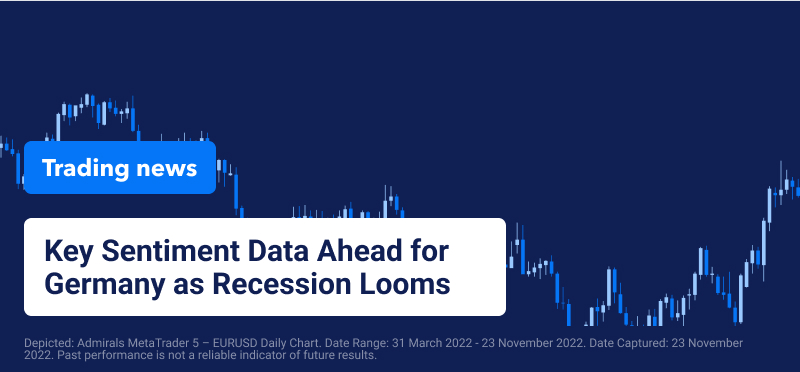[ad_1]

Eastern European countries such as the Czech Republic and Poland have seen their economies getting stronger in the last few years, quickly adopting to the European Union (EU) standards. The Czech Republic has not joined the euro bloc as it has kept the Czech Koruna to be able to alter monetary policy at will. The Czech Republic, just 3 decades after the breakup of Czechoslovakia, has one of the most competitive economies in the EU, which includes heavy industry such as car production lines etc.
In this blog, we will share some valuable insights regarding trading the Czech Koruna and the country’s economy that could help beginner traders shape an opinion about the currency’s future potential.
Table of Contents
Czech Economy Outlook, the Czech National Bank And The Czech Koruna
In its 2023 Economic Survey, the Organisation for Economic Cooperation and Development (OECD) predicts Czech GDP growth of 0.1% this year, before a rebound to 2.4% in 2024 as the global economy is likely to recover.
The OECD report is more optimistic than that of the Czech authorities. The Ministry of Finance predicts a decrease of 0.5%, and the Czech National Bank (CNB) 0.3%. The country has been in recession since mid-2022. The OECD report suggests inflation reaching 13.0% this year, while the ministry’s estimate is 10.4% and the CNB’s forecast is 10.8%. In 2024, the OECD predicts inflation will fall to 4.1%. The OECD says that the Czech Republic has one of highest core inflations in the EU and that inflation is broad-based and entrenched. Its analysts suggest that inflation will only approach the central bank’s 2% target at the end of 2024.
The Czech National Bank or Česká Národní Banka in Czech (CNB) was established in 1993 after the dissolution of Czechoslovakia. The CNB’s mission is to maintain price stability, to maintain financial stability and see to the sound operation of the financial system in the Czech Republic, to issue banknotes and coins, manage the circulation of currency and administer clearing between banks, and to supervise the entities operating on the financial market.
The Czech koruna (CZK) replaced the Czechoslovak koruna in 1993 after the dissolution of Czechoslovakia. The koruna is one of the European Union’s eight currencies. Although the Czech economy appears strong enough to adopt the single currency, there seems to be a powerful opposition to the move within the Czech Republic.
Trading The Czech Koruna: How It Has Performed
As the monthly chart shows, the Czech koruna has had many fluctuations against the US dollar since 2019. Just before the lockdown started in Europe (March 2020), one US dollar was equal to CZK 24.8. The Czech currency strengthened reaching a multi-month low in May 2021, trading at CZK 20.7 against its US counterpart.
Date Range: May 1st 2019 – August 24th 2023. Date Captured: August 24th 2023. Past Performance is not an indicator of future results.
However, the dollar started gaining ground against the Czech koruna, hitting a 2-year record high and trading at CZK 25.0 in September 2022.
Date Range: June 14th 2023 – August 24th 2023. Date Captured: August 24th 2023. Past Performance is not an indicator of future results.
The last few months were in favour of the Koruna which got a boost and trades between CZK 21.0-22.0 against the US dollar since the beginning of this year.
Analysts’ Forecasts Regarding The Czech Koruna
Commenting on the Czech central bank’s monetary policy, HSBC analysts wrote in their note to investors: “In our view, we have now reached the stage where the current growth-inflation mix no longer justifies such tight monetary conditions. Indeed, at its August meeting, the CNB announced an end to its FX intervention regime. The latest MPC minutes revealed that all members agreed there was no rush to cut rates. For us, the relatively hawkish stance on rates suggests that the CNB is not yet ready to loosen via its policy rates.”
Economists at Commerzbank expect the EUR/CZK pair to drift slightly lower this year before reversing the trend once again in 2024. In their report they wrote: “The central bank (CNB) announced an end to its FX intervention regime. This means that the central bank will not use FX intervention to prevent currency weakness. But, since no interventions were recently used, this makes no practical difference. Furthermore, if a new emergency situation were to arise, CNB could make another announcement and restart interventions. Hence, any currency weakness resulting from a kneejerk reaction in the market is likely to reverse over the coming quarters.”
Regarding the pair’s forecast for next year, they suggest: “In 2024, we see further risk of Koruna depreciation. The key risk is that inflation may not moderate fully to target, which will once again affect CNB’s credibility. What is more, controversy has broken out between government and central bank because the latter criticises the expansionary fiscal stance for being the main culprit behind high inflation. Such developments could add volatility to the CZK again next year if inflation were to prove stubborn as we anticipate.”
An ING report regarding inflation in the Czech Republic noted: “inflation path uncertainty is the main risk according to the board at the moment. Our forecast has remained unchanged for some time, with the CNB’s first rate cut in November. We think the condition is to see September inflation near 7% YoY, which is our forecast. This should give the board confidence that the inflation target is achievable in January next year. However, if the picture is not clear, the board may wait for January inflation which would mean delaying the cut until February or March 2024.”
How To Reduce Your Risk When Trading the Czech Koruna
If you decide to add the Czech Koruna to your trading portfolio, you should always remember that trading forex involves risk. In case your plan doesn’t work out because markets moved against you, there is a chance that you might lose funds in the process. Therefore, beginner traders should be very careful when engaging in trading.
One way to reduce risk is to boost your knowledge around trading. Brokers offer a wide array of educational materials and tools such as e-books, webinars, blogs and guides on how to trade while minimising risks. Beginner traders who understand how trading works and which are the dangers that could affect their financial plans are able to amend their strategies according to their goals.
Sometimes, knowledge may not be enough without the right tools. Especially in trading, having the necessary risk management tools available to use is imperative as without them the chances of failure increase. Brokers usually offer a suite of risk management tools such as the stop loss order that can put a stop to fund losses when the market fluctuates. Combining knowledge with suitable risk management tools can provide a worthy trading experience with less stress and anxiety.
Does trading on macroeconomic news interest you? Learn how this approach works with our free webinars. Meet and interact with expert traders. Watch and learn from live trading sessions.
This material does not contain and should not be construed as containing investment advice, investment recommendations, an offer of or solicitation for any transactions in financial instruments. Please note that such trading analysis is not a reliable indicator for any current or future performance, as circumstances may change over time. Before making any investment decisions, you should seek advice from independent financial advisors to ensure you understand the risks.
[ad_2]
Source link


